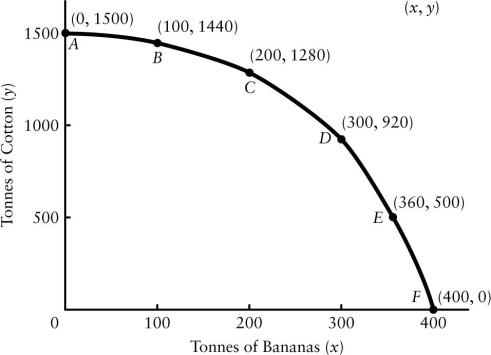Multiple Choice
Figure 1-7 shows the production possibilities boundary for an economy that produces two goods - cotton and bananas.  FIGURE 1-7
FIGURE 1-7
-Refer to Figure 1-7.A production possibilities boundary is shown for an economy that produces two goods - cotton and bananas,both measured in tonnes produced per year.Suppose this economy moves from point D to point F,where it is then producing bananas exclusively.Which of the following explanations best describes the opportunity cost involved in producing this extra 100 tonnes of bananas?
A) The opportunity cost is very high in this case because resources that are probably much better suited to producing cotton are now being devoted to producing bananas.
B) The opportunity cost is very low in this case because resources that are probably much better suited to producing cotton are now being devoted to producing bananas.
C) The opportunity cost is very high in this case because resources that are probably much better suited to producing bananas are now being devoted to producing cotton.
D) The opportunity cost is very low in this case because resources that are probably much better suited to producing bananas are now being devoted to producing cotton.
E) The opportunity cost of producing the extra bananas is independent of the amount being produced.
Correct Answer:

Verified
Correct Answer:
Verified
Q53: A farmer selling tomatoes and corn at
Q66: Scarcity arises from limited resources.For this reason,all
Q76: In command economies,economic behaviour is<br>A)largely determined by
Q79: A straight-line production possibilities boundary differs from
Q85: <img src="https://d2lvgg3v3hfg70.cloudfront.net/TB5441/.jpg" alt=" FIGURE 1-5 -Refer
Q88: With a budget of $500 000,a school
Q89: Which of the following is illustrated by
Q91: Madeleine allows herself $100 per month for
Q92: Suppose that a bakeshop with 5 employees
Q95: Consider a production possibilities boundary showing the